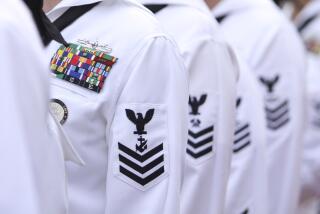Navy’s Blast Test Plan Assailed as a Relic : Empress II: ‘This is a dinosaur of the Cold War years,’ a critic says. But Soviets ‘still have a tremendous capability out there,’ a captain responds.
- Share via
WASHINGTON — In the two years since the Navy announced plans to put a nuclear blast simulator off the Alabama coast, the Cold War has ended, the Soviet Union has broken apart and President Bush has declared the threat of global war to be over.
But that hasn’t slowed the Navy’s plans to mount the device on a barge in the Gulf of Mexico. Over the next 20 years, it would fire pulses at passing Navy ships to determine if their electronic systems can survive a nuclear explosion.
“This is a dinosaur of the Cold War years,” said Andrew Kimbrell, a lawyer for the Washington-based Foundation on Economic Trends, which has been waging a legal battle against the project. “And unfortunately, it’s a very expensive and potentially hazardous dinosaur.”
The final environmental impact statement on the project was released last month and now the final decision is up to Secretary of the Navy H. Lawrence Garrett III.
The Electromagnetic Pulse Radiation Environmental Simulator, or Empress II as the project is commonly called, can create an electromagnetic field similar to one that would be generated on Earth by a nuclear explosion in space.
The pulser is surrounded by a cone of antennas 150 feet high and emits an electromagnetic pulse (EMP) that lasts just 10 billionths of a second.
The Navy plans to fire the pulse at passing ships to test the effectiveness of their electronic system protections. The first tests are scheduled for November, 1992, on the cruiser Anzio.
Development and construction of the barge has cost $60 million and the Anzio tests are expected to cost another $11 million.
Capt. William Mahew, manager of the Empress II program, acknowledged in a recent interview that the program would likely come under increasing scrutiny as defense budgets are cut. But he argued that it still is needed.
“Although the Soviets appear now to be a kinder, gentler nation, they still have a tremendous capability out there and they haven’t fallen off that very much,” Mahew said.
He also said the Navy had used the program to devise protections against electromagnetic interference from ships operating near each other.
The Navy’s final environmental impact statement on Empress II does not address whether it is still needed in light of the diminished threat of nuclear war. Kimbrell said that that omission is a critical failing.
“It seems to me it’s incumbent now on the Navy to say what validated threat scenario they are imaging and how does this program address a real, validated threat,” he said.
The Navy turned to Gulf of Mexico site--26 miles south of Mobile Bay--after environmental groups persuaded Congress to prohibit the tests in the Chesapeake Bay, the Navy’s first choice.
For the last several summers, the Navy has been conducting Empress II tests off the coast of North Carolina. The Foundation on Economic Trends has asked a federal judge to stop those tests until the Navy proves they pose no threat to human health, animal life, or the electronic circuity of nearby planes and boats. A trial date has not been set for the lawsuit.
Similar environmental concerns have been raised about the Gulf site, but the Navy’s final environmental impact statement said “scientific evidence and analyses have indicated that Empress II will not have any significant effect on the environment.”
The only impact foreseen by the Navy would be on airplanes and boats if they did not stay out of an exclusion zone around the barge during testing. The zone covers a radius of two nautical miles from the barge and 6,000 feet above it.
More to Read
Sign up for Essential California
The most important California stories and recommendations in your inbox every morning.
You may occasionally receive promotional content from the Los Angeles Times.













